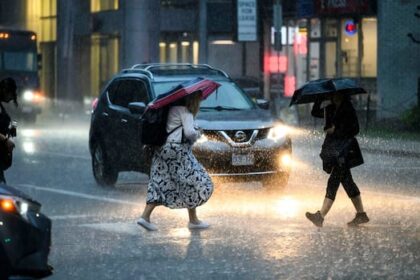PoliticsPrime Minister Mark Carney’s first budget delivers a historic investment in defence and the defence industry. But the fiscal plan is light on specifics on how and when the roughly $81.8 billion will be spent.Fiscal plan light on specifics on how and when the defence dollars will be spentMurray Brewster · CBC News · Posted: Nov 04, 2025 4:00 AM EST | Last Updated: 3 hours agoListen to this articleEstimated 6 minutesNational Defence Minister David McGuinty, left, and Prime Minister Mark Carney are seen during a tour of the Hanwha Ocean Shipyard in Geoje, South Korea, on Thursday. No specific funding was announced for subs in Tuesday’s budget. (Adrian Wyld/The Canadian Press)The Liberal government has set aside an additional $81.8 billion over five years to rearm the Canadian military, but the new federal budget offers only a vague, big-picture view on how the money will be spent over five years.It also does not spell out in precise detail the politically important pathway to meeting NATO’s defence spending target of five per cent of the gross domestic product.There is more money for recruiting, training, new equipment, defence infrastructure and beefing up cyber defence capabilities in the fiscal plan, tabled in the House of Commons on Tuesday.“Budget 2025 represents the largest defence investment in decades,” Finance Minister François-Philippe Champagne said in his budget speech.“We will meet our NATO two per cent commitment this year, modernize NORAD, reinforce our Arctic defences and equip the brave women and men of the Canadian Armed Forces with the infrastructure and technology they need to safeguard our nation.”WATCH | Who’s getting in line for Canada’s defence spending?:Canada’s $8.7B defence spend: Who’s getting in lineAfter decades of moving slowly, Canada is suddenly pouring billions into defence — and fast. For The National, CBC News chief correspondent Adrienne Arsenault looks at how the industry is gearing up and meets the companies eager to show off what’s for sale.Champagne touted the new budget as “a blueprint to defend our sovereignty” but given the lack of detail on how the historic investment will be spent, one expert suggests, it might be better described as a rough sketch.The budget paints, in broad strokes, stepped-up investment in the defence industry — $6.6 billion over five years — and it has set aside money for the establishment of the recently announced Defence Investment Agency.The budget doesn’t offer a precise list of the military equipment the government intends to buy, including, significantly, submarines. The government has signalled it wants to move swiftly to deliver a contract but federal officials confirmed no money has been set aside for the program.However, the budget delivered by Champagne doesn’t say precisely how big the defence appropriation will be in the coming year. At the moment, the federal government is projected to spend $62 billion on defence.There is, unlike previous budgets, no year-by-year breakdown of defence spending for the fiscal horizon. The numbers are presented as lump-sum projections over five years. Federal officials were asked for the breakdown for the 2026-27 budget year and subsequent years, but said they couldn’t provide them.The new budget also doesn’t offer a comparison of the planned spending to the country’s projected gross domestic product (GDP), the metric by which allies measure defence expenditures.In response to relentless pressure from allies, notably the Trump administration, Prime Minister Mark Carney pledged to raise Canada’s defence spending to two per cent of GDP by the end of the current fiscal year. At the NATO summit last summer, he further committed to raising the level to five per cent of GDP (3.5 per cent directly spent on the military and 1.5 per cent for defence infrastructure). Of the $81.8 billion included in Tuesday’s budget, roughly $9 billion was previously announced by Carney last June when he first pledged to reach the two per cent target by March 31, 2026.Defence Minister David McGuinty, speaking in South Korea last week, said the budget would “begin laying track to meet the five per cent target by 2035.”The absence of detail makes it hard to know — except in the most general of terms — whether the government can actually meet the ambitious goal, said one defence expert. “It’s really kind of curious to me that a government that has made so much of wanting to commit to NATO targets has really only provided a book end,” said Dave Perry, president of the Canadian Global Affairs Institute.Navy commander Vice-Admiral Angus Topshee, left, and Cmdr. Nicole Robichaud, are seen at HMCS Margaret Brooke’s commissioning ceremony in Halifax on Oct. 28, 2022. HMCS Margaret Brooke is the second Arctic and offshore patrol ship delivered under the National Shipbuilding Strategy. (Andrew Vaughan/The Canadian Press)“They say we’re going to be at two per cent this year and 10 years from now we’ll be at three-and-a-half per cent. Where it sits between this year and 10 years from now is completely unclear.”Interestingly, the budget does say that the defence infrastructure portion of the NATO spending commitment is already covered by the current combined spending plans of the federal, provincial and municipal governments when it comes to emergency management and the telecommunications network that knits them together.The overall budget is sprinkled with references to defence, whether it is retooling the federal Export Development Corporation to support Canadian defence industry exports or support for extracting critical minerals to the new Buy Canada Policy.There’s even a defence reference in the portion of the budget that deals with the $1 billion Arctic Infrastructure Fund.“Our work on defence will strengthen Canadian research centres, and Canadian communities in the North, working with our Inuit and First Nations partners, by building dual-use infrastructure — like ports and airport runways,” Champagne said in his budget speech. “We will further build our security and defence capabilities, right here at home — creating new jobs for our engineers, technicians and scientists in sectors such as aerospace, shipbuilding, cybersecurity and AI.”CBC News chief political correspondent Rosemary Barton hosts special coverage of Prime Minister Mark Carney’s first federal budget, on CBC-TV and CBC News Network at 3 p.m. ET. Power & Politics will provide further analysis on CBC News Network at 5 p.m. ET.On radio, Your World Tonight’s Susan Bonner and Catherine Cullen of The House host special coverage beginning at 4 p.m. ET on CBC Radio and the CBC Listen app.Coverage will also stream live on CBC Gem, the CBC News App and on the CBC News YouTube (3 to 7 p.m. ET) and TikTok (3 to 5 p.m. ET) channels. ABOUT THE AUTHORMurray Brewster is senior defence writer for CBC News, based in Ottawa. He has covered the Canadian military and foreign policy from Parliament Hill for over a decade. Among other assignments, he spent a total of 15 months on the ground covering the Afghan war for The Canadian Press. Prior to that, he covered defence issues and politics for CP in Nova Scotia for 11 years and was bureau chief for Standard Broadcast News in Ottawa.Follow Murray Brewster on Twitter
Budget touts $81.8B defence investment as a sovereignty ‘blueprint’ but offers only rough fiscal sketches











